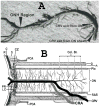Natural history of visual outcome in central retinal vein occlusion
- PMID: 20723991
- PMCID: PMC2989417
- DOI: 10.1016/j.ophtha.2010.04.019
Natural history of visual outcome in central retinal vein occlusion
Abstract
Objective: To investigate systematically the natural history of visual outcome in central retinal vein occlusion (CRVO).
Design: Cohort study.
Participants: Six hundred sixty-seven consecutive patients (30 patients had both eyes involved resulting in 697 eyes) with CRVO first seen in the authors' clinic from 1973 through 2000.
Methods: At the first visit, all patients underwent a detailed ophthalmic and medical history and a comprehensive ophthalmic evaluation. Visual evaluation was carried out by recording visual acuity, using the Snellen visual acuity chart, and assessing visual fields with a Goldmann perimeter. The same ophthalmic evaluation was performed at each follow-up visit. Central retinal vein occlusion was classified into nonischemic (588 eyes) and ischemic (109 eyes) types at the initial visit based on functional and morphologic criteria.
Main outcome measures: Visual acuity and visual fields.
Results: Of the eyes first seen within 3 months, visual acuity was 20/100 or better in 78% with nonischemic CRVO and in only 1% with ischemic CRVO (P < 0.0001), and visual field defects were minimal or mild in 91% and 8%, respectively (P < 0.0001). Final visual acuity, on resolution of macular edema, was 20/100 or better in 83% with nonischemic CRVO and in only 12% with ischemic CRVO (P < 0.0001), and visual field defects were minimal or mild in 95% and 18%, respectively (P < 0.0001). On resolution of macular edema, in eyes with initial visual acuity of 20/70 or worse, visual acuity improved in 59% with nonischemic CRVO, with no significant (P = 0.55) improvement in ischemic CRVO. Similarly, on resolution of macular edema, in eyes with moderate to severe initial visual field defect, improvement was seen in 86% of nonischemic CRVO eyes, but no significant (P = 0.83) improvement was seen in eyes with ischemic CRVO. In nonischemic CRVO, development of foveal pigmentary degeneration, epiretinal membrane, or both, was the main cause of poor final visual acuity. This shows that initial presentation and the final visual outcome in the 2 types of CRVO are entirely different.
Conclusions: A clear differentiation of CRVO into nonischemic and ischemic types, based primarily on functional criteria, is crucial and fundamental in determining visual outcome. Visual outcome is good in nonischemic CRVO and poor in ischemic CRVO.
Copyright © 2011. Published by Elsevier Inc.
Figures

References
-
- Michel J. Ueber die anatomischen Ursachen von Veraenderungen des Augenhintergrundes bei einigen Allgemeinerkrankungen. Dtsch Arch Klin Med. 1878;22:339–45.
-
- Moore RF. Br J Ophthalmol Monograph. suppl 2. London: Pulman; 1924. Retinal venous thrombosis: A clinical study of sixty-two cases followed over many years; pp. 1–90.
-
- Zegarra H, Gutman FA, Conforto J. The natural course of central retinal vein occlusion. Ophthalmology. 1979;86:1931–42. - PubMed
-
- Quinlan PM, Elman MJ, Bhatt AK, et al. The natural course of central retinal vein occlusion. Am J Ophthalmol. 1990;110:118–23. - PubMed
-
- Chen JC, Klein ML, Watzke RC, et al. Natural course of perfused central retinal vein occlusion. Can J Ophthalmol. 1995;30:21–4. - PubMed
Publication types
MeSH terms
Grants and funding
LinkOut - more resources
Full Text Sources

